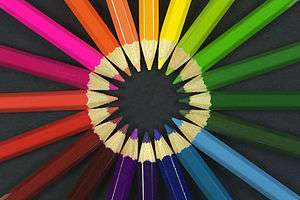Outline of the visual arts

Colour is an important aspect of many of the visual arts.
The following outline is provided as an overview of and topical guide to the visual arts:
Visual arts – class of art forms, including painting, sculpture, photography, printmaking and others, that focus on the creation of works which are primarily visual in nature. Visual Arts that produce three-dimensional objects, such as sculpture and architecture, are known as plastic arts. The current usage of visual arts includes fine arts as well as crafts, but this was not always the case.
Types of visual art
- Architecture, process and product of planning, designing and construction. Architectural works, in the material form of buildings, are often perceived as cultural and political symbols and as works of art.
- Arts and crafts
- Asemic writing
- Animation
- Calligraphy
- Cartoon
- Ceramic art
- Collage
- Comics
- Conceptual art
- Decollage
- Decorative art
- Design, as a verb, it refers to the process of originating and developing a plan for a new object (machine, building, product, etc.). As a noun, it is used both for the final plan or proposal (a drawing, model, or other description), or the result of implementing that plan or proposal (the object produced).
- Fashion design
- Garden design
- Graphic design
- Motion graphic design
- Web design, creation and maintenance of websites
- Drawing
- Film
- Found object
- Graffiti
- Illustration
- Installation art
- Land art
- Mail art
- Mixed media
- Painting
- Photography
- Printmaking
- Sculpture
- Typography
- Video art
History of the visual arts
 |
| History of art |
| Art history |
- History of animation
- Arts and Crafts movement
- History of ceramic art
- History of comics
- History of conceptual art
- History of decorative arts
- History of drawing
- History of fashion design
- History of film
- History of graffiti
- History of illustration
- History of installation art
- Mixed media#History of mixed media
- History of painting
- History of photography
- History of printmaking
- History of sculpture
- History of video art
By location
Elements of art
Elements of art – shape, form, value, line, color, space and texture
- Shape – area defined by edges
- Form – perceived volume or dimensionality
- Value – use of lightness (tint, or white) and darkness (shade, or black) in a piece of art
- Line – straight or curved marks that span a distance between two points. For example, see line art.
- Color – produced when light, striking an object, is reflected back to the eye.
- Properties of color
- Hue – red, yellow, blue, green, etc.
- Intensity
- Value (brightness)
- Properties of color
- Space – area that an artist provides for a particular purpose. Space includes the background, foreground and middle ground, and refers to the distances or area(s) around, between, and within things.
- Texture – the way a three-dimensional work actually feels when touched, or the visual "feel" of a two-dimensional work
General visual art concepts
Main article: Principles of art
Visual artists
- List of animators
- List of fashion designers
- List of film and television directors
- List of painters
- List of photographers
- List of sculptors
- List of studio potters
- List of people associated with the Académie Julian
See also
External links
- ArtLex - online dictionary of visual art terms.
- Art History Timeline by the Metropolitan Museum of Art.
This article is issued from Wikipedia - version of the 10/11/2016. The text is available under the Creative Commons Attribution/Share Alike but additional terms may apply for the media files.
